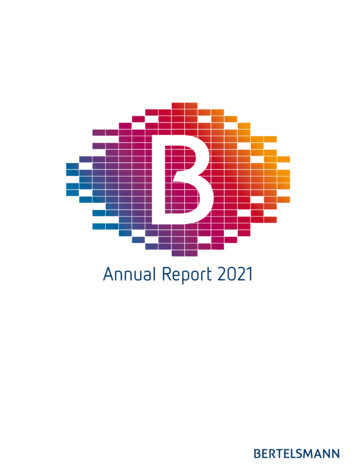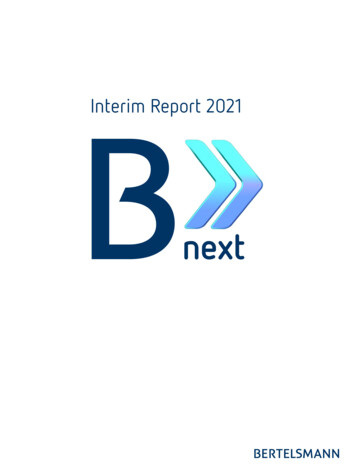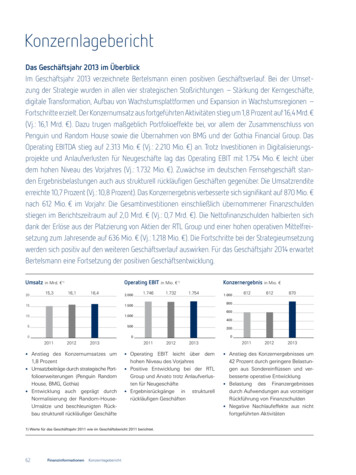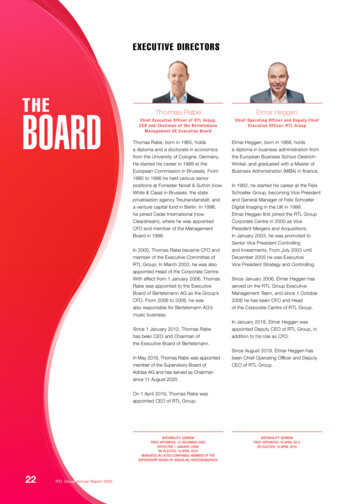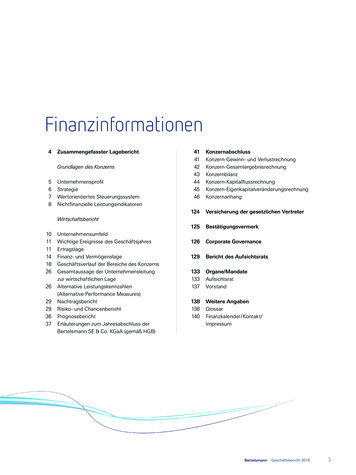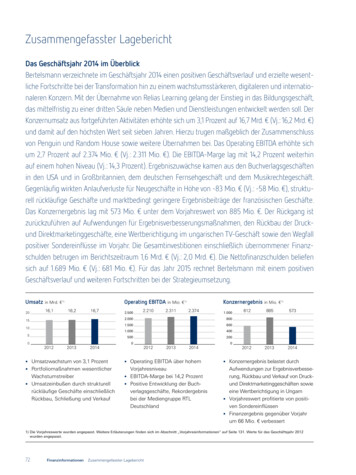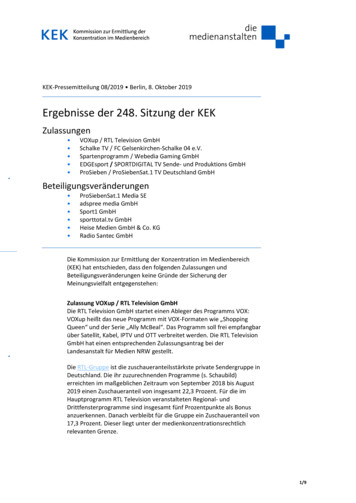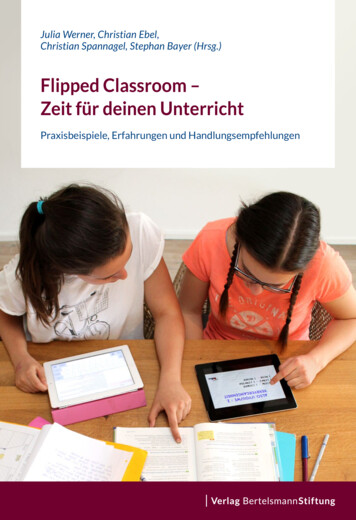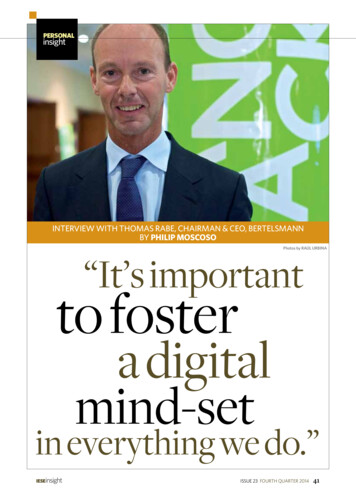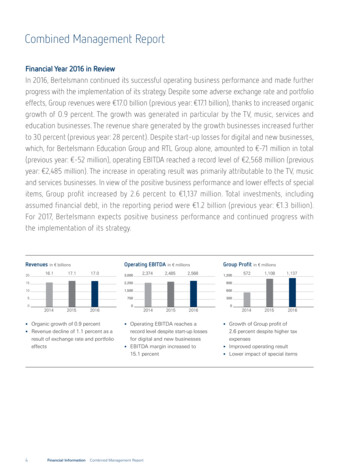
Transcription
Combined Management ReportFinancial Year 2016 in ReviewIn 2016, Bertelsmann continued its successful operating business performance and made furtherprogress with the implementation of its strategy. Despite some adverse exchange rate and portfolioeffects, Group revenues were 17.0 billion (previous year: 17.1 billion), thanks to increased organicgrowth of 0.9 percent. The growth was generated in particular by the TV, music, services andeducation businesses. The revenue share generated by the growth businesses increased furtherto 30 percent (previous year: 28 percent). Despite start-up losses for digital and new businesses,which, for Bertelsmann Education Group and RTL Group alone, amounted to -71 million in total(previous year: -52 million), operating EBITDA reached a record level of 2,568 million (previousyear: 2,485 million). The increase in operating result was primarily attributable to the TV, musicand services businesses. In view of the positive business performance and lower effects of specialitems, Group profit increased by 2.6 percent to 1,137 million. Total investments, includingassumed financial debt, in the reporting period were 1.2 billion (previous year: 1.3 billion).For 2017, Bertelsmann expects positive business performance and continued progress withthe implementation of its strategy.Operating EBITDA in millionsRevenues in billions2016.117.117.03,0002,3742,4852,568Group Profit in 201620142015201605721,1081,137201420152016 Organic growth of 0.9 percent Operating EBITDA reaches a Growth of Group profit of Revenue decline of 1.1 percent as arecord level despite start-up lossesfor digital and new businesses EBITDA margin increased to15.1 percent2.6 percent despite higher taxexpenses Improved operating result Lower impact of special itemsresult of exchange rate and portfolioeffects4Financial InformationCombined Management Report
Fundamental Information about the GroupIn this Management Report, the Group is using the option tocombine the Group Management Report and the ManagementReport of Bertelsmann SE & Co. KGaA. This CombinedManagement Report outlines the business performance,including the business result and the position of theBertelsmann Group and Bertelsmann SE & Co. KGaA. Information about Bertelsmann SE & Co. KGaA in accordancewith the German Commercial Code (HGB) will be detailed in aseparate section. The Combined Management Report will bepublished instead of the Group Management Report withinthe Bertelsmann Annual Report.Corporate ProfileBertelsmann operates in the core business fields of media,services and education in around 50 countries worldwide. Thegeographic core markets are Western Europe – in particular,Germany, France and the United Kingdom – and theUnited States. In addition, Bertelsmann is strengthening itsinvolvement in growth markets such as China, India andBrazil. The Bertelsmann divisions are RTL Group (television),Penguin Random House (books), Gruner Jahr (magazines),BMG (music), Arvato (services), Bertelsmann Printing Group(printing), Bertelsmann Education Group (education) andBertelsmann Investments (funds).Bertelsmann SE & Co. KGaA is a capital-market-oriented butunlisted partnership limited by shares. As a Group holdingcompany, it exercises central corporate functions such as thespecification and development of the Group’s strategy, capitalallocation, financing and management development. Internalcorporate management and reporting follow the Group’sorganizational structure, which consists of the operatingdivisions and Corporate.RTL Group is, based on revenue, one of the leading television groups in the broadcasting, content and digital businesswith interests in 60 television channels, 31 radio stations andcontent production throughout the world. The television portfolio of RTL Group includes RTL Television in Germany, M6in France and the RTL channels in the Netherlands, Belgium,Luxembourg, Croatia and Hungary, as well as investments inAtresmedia in Spain and RTL CBS Asia Entertainment Networkin Southeast Asia. Fremantle Media is one of the largest international creators, producers and distributors of a wide rangeof formats outside the United States. Combining the catch-upTV services of its broadcasters, the multichannel networksBroadbandTV, StyleHaul and Divimove and Fremantle Media’s260 YouTube channels, RTL Group has become the leadingEuropean media company based on online video views.Furthermore, RTL Group owns a majority stake in SpotX, aprogrammatic video advertising platform. The publicly tradedRTL Group S.A. is listed on the German MDAX index.Penguin Random House is, based on revenue, the world’s largest trade book publisher, with more than 250 imprints acrossfive continents. Its book brands include storied imprints such asDoubleday, Viking and Alfred A. Knopf (United States); Ebury,Hamish Hamilton and Jonathan Cape (United Kingdom); Plaza &Janés and Alfaguara (Spain) and Sudamericana (Argentina), aswell as the international imprint Dorling Kindersley. Each yearPenguin Random House publishes over 15,000 new titles andsells nearly 800 million print books, e-books and audio books.Germany’s Verlagsgruppe Random House, which includesillustrious publishing houses such as Goldmann and Heyne, isnot part of Penguin Random House from a legal point of view,but is under the same corporate management and is part of thePenguin Random House division.Gruner Jahr is represented in over 20 countries with morethan 500 magazines and digital businesses. G J Germanypublishes well-known magazines such as “Stern,” “Brigitte”and “Geo.” The digital business consists of publishingofferings, communities, commerce transactions such as the“Schöner Wohnen” shop and the Ligatus Ad-Tech business.Gruner Jahr owns 59.9 percent of Motor Presse Stuttgart.In France, G J operates Prisma Media, the country’s largestprint and digital magazine publisher in terms of overall reach.BMG is an international group that manages music publishingrights and recording rights. With 14 branches in 12 majormusic markets, BMG now represents more than 2.5 millionsongs and recordings, including those in the catalogs ofChrysalis, Bug, Cherry Lane, Sanctuary, Primary Wave andAlberts Music.Arvato develops and implements innovative solutions forcustomers in a wide range of sectors in over 40 countries forall kinds of business processes. These comprise CustomerRelationship Management (CRM), Supply Chain Management(SCM), Financial Solutions and IT Services.The Bertelsmann Printing Group bundles all of Bertelsmann’soffset and gravure printing activities. It comprises the GermanBertelsmannAnnual Report 20165
offset printers Mohn Media, GGP Media and Vogel Druck;the gravure activities of Prinovis in Germany and the UnitedKingdom; and the offset and digital printers Berryville Graphics,Coral Graphics and OPM in the United States. The group offersa wide range of print and other services. The BertelsmannPrinting Group also includes RTV Media Group, the creativeservices provider MBS and the storage media producer Sonopress.Bertelsmann Education Group comprises Bertelsmann’s education activities. The digital education and service offerings areprimarily in the healthcare and technology sectors. The educationactivities include the e-learning providers Relias Learning andUdacity and the investments in the online education platformHotChalk and in Alliant International University.Bertelsmann Investments bundles Bertelsmann’s global start-upinvestments. The activities are focused on the strategic growthmarkets of Brazil, China and India and on the United States andEurope. Investments are made through the funds BertelsmannBrazil Investments (BBI), Bertelsmann Asia Investments (BAI),Bertelsmann India Investments (BII) and Bertelsmann DigitalMedia Investments (BDMI).Regulatory EnvironmentBertelsmann has television and radio operations in severalEuropean countries that are subject to regulation. In Germany,for example, media are subject to oversight by the Commissionon Concentration in the Media. Bertelsmann Group companiesoccupy leading market positions in many lines of businessand may therefore have limited potential for growth throughacquisition due to antitrust legislation. Moreover, someeducation activities are subject to regulatory provisions ofgovernment authorities and accreditation bodies.Because its profit participation certificates and bonds arepublicly listed, Bertelsmann is required to comply in fullwith capital market regulations applicable to publicly tradedcompanies.Shareholder StructureBertelsmann SE & Co. KGaA is an unlisted partnership limitedby shares. Three foundations (Bertelsmann Stiftung, ReinhardMohn Stiftung and BVG-Stiftung) indirectly hold 80.9 percentof Bertelsmann SE & Co. KGaA shares, with the remaining19.1 percent held indirectly by the Mohn family. BertelsmannVerwaltungsgesellschaft (BVG) controls all voting rights atthe General Meeting of Bertelsmann SE & Co. KGaA andBertelsmann Management SE (general partner).6Financial InformationCombined Management ReportStrategyBertelsmann’s primary objective is continuous growth of thecompany’s value through a sustained increase in profitabilitywith efficient capital investment at the same time (see the“Value-Oriented Management System” section).Bertelsmann aims to achieve a faster-growing, more digital,more international and more diversified Group portfolio.Businesses in which Bertelsmann invests should have longterm stable growth, global reach, stable and protectablebusiness models, high market-entry barriers and scalability. Theeducation business is being gradually developed into the thirdearnings pillar alongside the media and service businesses.Group strategy comprises four strategic priorities – strengthening the core businesses, driving the digital transformation forward, developing growth platforms and expanding into growthregions. In the financial year 2016, Bertelsmann continued tomake significant progress in line with these strategic priorities.As part of strengthening the core businesses, the Ad Alliancewas formed as a cooperation in advertising marketingbetween Mediengruppe RTL Deutschland and Gruner Jahr.In 2016, RTL Group launched new TV channels. Gruner Jahrfounded Deutsche Medien-Manufaktur in conjunction withLandwirtschaftsverlag and also focused on the core marketsof Germany and France through the disposals of the publishinggroup News in Austria and G J Spain. A new managementstructure was implemented at Bertelsmann Printing Group.Bertelsmann continued to roll out the Group-wide earningsimprovement program.The Group also pushed forward with the digital transformation atRTL Group, through the takeover of the online video marketerSmartclip among other things. Gruner Jahr expanded itsdigital businesses primarily through the acquisition of theFrench digital video provider Groupe Cerise, the takeover ofthe demand-side platform provider LiquidM and the increasein its stake in (and thus complete takeover of) the marketing services provider trnd. Arvato generated growth throughservices for companies in the IT/high-tech sector and withe-commerce services.The growth platforms were strengthened through the acquisition of a majority share in the ARC Music publishing catalogand signing contracts with many new artists at BMG – including Pink Floyd founding member and songwriter RogerWaters. BMG also entered the Australian market andtook over the Australian music publisher Alberts. Arvatocreated the conditions for the further expansion of its SCM
services by developing a new logistics center in the EasternRuhr region and also commissioning a distribution center inGennep, Netherlands. In addition, Arvato posted further salessuccesses in the Financial Solutions division. The educationbusiness was further reinforced by, among other things, thecontinued organic and acquisitive expansion of the activities ofRelias Learning. For example, Relias Learning expanded internationally and took over the US companies CMT, AHC Mediaand Swank Healthcare, among others. The e-learning providerUdacity also continued to expand its business internationallyand is now also operating in Brazil, China, India and Germanywith its Nanodegree offerings.As part of expanding its presence in growth regions, the BAIfund made further new and follow-up investments in Chinaand made a positive contribution to Group profit throughgains from disposals of investments. In India, Bertelsmannstrengthened its activities in strategically relevant businessareas by acquiring stakes in the e-commerce servicesprovider KartRocket, the social fashion network Roposo, thebudget hotel marketplace Treebo and the Fintech companyLendingkart. BBI in cooperation with its strategic partnerBozano Investimentos took stakes in the university educationprovider Medcel and the NRE Education Group.Bertelsmann will push ahead with its transformation into afaster-growing, more digital, more international and morediversified Group in 2017 in line with the four strategic priorities. Compliance with and achievement of the strategic development priorities are continuously examined by the ExecutiveBoard at the divisional level through regular meetings of theStrategy and Business Committee and as part of the annualStrategic Planning Dialogue between the Executive Board andthe Supervisory Board. In addition, relevant markets and thecompetitive environment are analyzed on an ongoing basis inorder to draw conclusions concerning the further developmentof the Group’s strategy. The Executive Board is also supportedby the Group Management Committee (GMC) on issues ofcorporate strategy and development. This Committee is composed of executives representing key businesses, countries,regions and select Group-wide functions.The Group’s content-based and entrepreneurial creativity willremain very important for the implementation of its strategy.Bertelsmann will therefore continue to invest significantly inthe creative core of its businesses. In addition, Bertelsmannneeds to have qualified employees at all levels of the Groupto ensure its strategic and financial success. Innovation competence is also very important for Bertelsmann and is a keystrategic component (see the “Innovations” section).Value-Oriented Management SystemBertelsmann’s primary objective is continuous growth of thecompany’s value through a sustained increase in profitability.In order to manage the Group, Bertelsmann has been usinga value-oriented management system for many years, whichfocuses on revenues, operating earnings and optimum capitalinvestment. For formal reasons, Bertelsmann makes a distinction between strictly defined and broadly defined operationalperformance indicators.Strictly defined operational performance indicators, includingrevenues, operating EBITDA and Bertelsmann Value Added(BVA), are used to directly assess current business performance and are correspondingly used in the outlook. These aredistinguished from performance indicators used in the broadersense, which are partially derived from the above-mentionedindicators or are strongly influenced by these. These includethe EBITDA margin and the cash conversion rate. The financialmanagement system, with defined internal financing targets,is also part of the broadly defined value-oriented managementsystem. Details of the expected development of performanceindicators used in the broader sense are provided as additionalinformation and are not included in the outlook.In order to explain the business performance and to controland manage the Group, Bertelsmann also uses alternativeperformance measures that are not defined in accordance withIFRS (more details are given in the “Alternative PerformanceMeasures” section).Strictly Defined Operational Performance IndicatorsIn order to control and manage the Group, Bertelsmann usesrevenues, operating EBITDA and BVA as performance indicators. Revenue is used as a growth indicator of businesses.In the financial year 2016, organic growth was 0.9 percent.Group revenues of 17.0 billion were 1.1 percent below theprevious year’s figure (previous year: 17.1 billion) due toexchange rate and portfolio effects.A key performance indicator for measuring the profitabilityof the Bertelsmann Group and the divisions is the operatingEBITDA. Operating EBITDA increased to 2,568 million(previous year: 2,485 million) in the reporting period.Bertelsmann uses BVA for assessing the profitability of operations and return on invested capital. BVA measures the profitrealized above and beyond the appropriate return on investedcapital. BVA in the financial year 2016 was 147 million comparedBertelsmannAnnual Report 20167
to the previous year’s figure of 155 million. The impact of theincrease in average invested capital could only partially be offsetby the improved year-on-year operating earnings.Broadly Defined Performance IndicatorsIn order to assess business development, other performanceindicators are used that are partially derived from revenues andoperating EBITDA or are strongly influenced by these figures.The cash conversion rate serves as a measure of cash generatedfrom business activities, which should be between 90 and100 percent as a long-term average. The cash conversion ratein the financial year 2016 increased to 93 percent (previousyear: 83 percent) as a result of an improved cash generationfrom operations and an associated increase in cash flow fromoperating activities.The EBITDA margin is used as an additional criterion forassessing business performance. The EBITDA margin in thefinancial year 2016 improved to 15.1 percent compared to14.5 percent in the previous year.Bertelsmann’s financial management and controlling systemis defined by the internal financial targets outlined in the“Net Assets and Financial Position” section. These financingprinciples are pursued in the management of the Group andare included in the broadly defined value-oriented management system.The non-financial performance indicators (employees, corporateresponsibility and innovations) are not included in the broadlydefined value-oriented management system. As they can onlybe measured to a limited extent, it is not possible to make anyclear quantifiable statements concerning interrelated effects andvalue increases. For this reason, the non-financial performanceindicators are not used for the management of the Group.Non-Financial Performance Indicatorsadaptation of the central talent management processes andtools and the establishment of further talent pools.Continuous employee training is the basis of a company’sfuture economic success. In view of this, the training coursesoffered by Bertelsmann University have been further digitized and expanded. Furthermore, at the end of 2016, some80,000 employees in 31 countries were able to access trainingcourses on the Group-wide “peoplenet” HR IT platform.At Bertelsmann, partnership primarily involves working withemployees to shape the company. For this reason, theEmployee Survey has been an important tool for many years atBertelsmann. In 2016, 89 percent of employees took part in theworldwide survey. Supporting dialogue between the employeerepresentatives and dialogue with Bertelsmann managementis also very important for a cooperative corporate culture. Asa result of this, a number of conferences were held in 2016that, in particular, looked at how changes could be addressed.At the Diversity Conference in February 2016, business caseson the topic of diversity within the Group were presented andnew concepts developed.One priority of the HR strategy is the Bertelsmann Sense ofPurpose. The Sense of Purpose “To Empower. To Create. ToInspire.” was formulated and communicated in an international dialogue with various stakeholders.Bertelsmann has been one of the pioneers in profit sharing since1970. Thus, a total of 95 million (previous year: 85 million)was distributed to employees worldwide in 2016, thanks tothe positive operating results for the previous year.Corporate ResponsibilityThe aim of corporate responsibility (CR) at Bertelsmann is tobring the economic interests in line with the Group’s socialand ecological concerns as part of a dialogue with all relevantstakeholders.At the end of the financial year 2016, the Group had116,434 employees worldwide. In 2016, there were 1,225 peopleserving in trainee positions in Bertelsmann companies inGermany.In view of this, the Bertelsmann Corporate ResponsibilityCouncil continued its cross-divisional dialogue and the strategicfurther development of significant Group-wide CR topics in2016. The focus here was on employee concerns such astraining, fair working conditions, health and diversity, societaland environmental concerns such as freedom of the press,media user/customer protection and eco-efficiency.The purpose of the human resources (HR) strategy is tosupport the implementation of the Group’s strategy. In2016, the main focus was again on the further developmentand training of employees. This included a comprehensiveIn 2016, Bertelsmann reported on its activities in theseareas in the magazine “24/7 Responsibility.” The Group alsopublished an online index on its website in accordance withthe guidelines of the Global Reporting Initiative (GRI G4)Employees8Financial InformationCombined Management Report
and Bertelsmann’s fifth annual Carbon Footprint report withextensive details regarding greenhouse gas emissions andfurther environmental data.and the provision and use of data, the position of Head ofSmart Data was created at Mediengruppe RTL Deutschlandin 2016.Also in 2016, Bertelsmann made donations and was involvedin a wide range of funding initiatives in the areas of education,culture, science and creativity.The innovations at Penguin Random House incorporate anumber of key areas, including innovative approaches towardcontent, distribution and interaction with consumers. In thedigital sector the company is exploring new technologies inconjunction with well-known industry players. One exampleof this from the United States is the recording of children’sbook titles on the voice-activated platform Google Home.Penguin Random House also continues to identify new ways inwhich readers can discover authors and their works in order toreach the widest possible audience. Examples of this include“Subway Reads,” an eight-week advertising campaign in theUnited States, where train commuters were offered e-booksby Penguin Random House, and “Puffin World of Stories,”a partnership with OnBlackheath for a family festival in theUnited Kingdom.InnovationsBusinesses invest in the research and development of newproducts in order to ensure their long-term competitiveness.The media sector has a similar imperative to create innovativemedia content and media-related products and servicesin a rapidly changing environment. This means that ratherthan conventional research and development activities, thecompany’s own innovative power and business developmentare particularly important to Bertelsmann. The long-termsuccess of the Group depends heavily on product innovations,investing in growth markets and integrating new technologies. Furthermore, innovative expertise is very important forstrategy implementation and, in the future, will be anchoredeven more strongly within the Bertelsmann Group in organizational terms.Bertelsmann relies on innovation and growth in coreoperations and new business fields. The key success factorsof Bertelsmann’s innovation management include continuouslyfollowing cross-industry trends and observing new markets.At the Group level, Bertelsmann works with the divisions tocontinuously identify and implement innovative businessstrategies. Alongside market-oriented activities, support isgiven to Group-wide initiatives that actively promote knowledgetransfer and collaboration. At regular innovation forums,executives meet with internal and external experts to examinesuccess factors for innovation and creativity.The innovations at RTL Group are focused on three coretopics – developing and acquiring new, high-quality TV contentand formats, using all digital means of distribution, andexpanding diverse forms of advertising sales and monetization.The new innovative TV formats include “The Young Pope,”a production by the Italian Fremantle Media subsidiaryWildside, and the adaptation of the novel “American Gods” byFremantle Media North America that is currently in production.RTL Group also expanded its position in the marketing ofonline videos. In particular, the takeover of Smartclip byMediengruppe RTL Deutschland reinforced the technologicalcompetence of RTL Group and offers global innovationopportunities in cooperation with SpotX. Synergy Committeesare used for exchanging information and knowledge withinRTL Group. As a result of the growing significance of big dataAs well as the digital transformation, the innovations atGruner Jahr in various market segments were also a keyfocus in 2016. The digital business also grew strongly as aresult of significantly increased advertising revenues fromthe brand websites and at the performance marketer Ligatusthrough innovative developments such as the marketing platforms InCircles and AppLike or the multichannel food network“Club of Cooks.” G J expanded its e-commerce activitieswith the “Schöner Wohnen” shop. The publishing houseDeutsche Medien-Manufaktur founded by Gruner Jahr andLandwirtschaftsverlag successfully launched innovative magazines such as “Wolf” and “Essen & Trinken mit Thermomix.”G J also formed Germany’s largest provider of content communication services, Territory.The innovations at BMG concern market access and productinnovations in particular. In 2016 these included the globalbundling of distribution in the label business into one distribution partner (Warner/ADA) and the creation of the songwriter workshop model SoundLab. In China, BMG expandedits cooperation with Alibaba Music, the music division of thee-commerce company Alibaba, with the aim of developingnew music offerings for the Chinese market and to make iteasier for international artists to access digital music platformsin China. In the digital sector, BMG extended the management of audiovisual content to live streaming and was able tostream excerpts from concerts by the artists Albert Hammond,Katie Melua and LP live on the Internet as part of its televisionprogram “Berlin Live” in cooperation with Arte.The innovations at Arvato were driven forward in a number ofdifferent areas. These include promoting internal dialogue onBertelsmannAnnual Report 20169
innovation topics, analyzing the use of innovative technologies,investing in innovative projects in the area of cloud infrastructure, creating innovation partnerships with companies such asIBM Watson, developing new products and solutions in the areaof fraud prevention, and investing in innovative companies.The innovations of the Bertelsmann Printing Group are mainlyin optimizing technology and processes and in developingnew products and services. One innovative approach is thedevelopment and launch of the optical data carrier Ultra HDBlu-ray 100 by Sonopress. In summer 2016, the storagemedia producer Sonopress obtained the certification for theinnovative optical data carrier, commenced fully automatedproduction of the innovative data carrier and thus successfullypositioned itself in a new market segment.The innovations at Bertelsmann Education Group refer to thefurther development of digital education offerings. For example,Relias Learning developed over 400 new online courses foremployees in the healthcare sector and started local coursesin the United Kingdom, Germany and China. The group wasalso able to expand its capabilities in the area of analytics withthe aim of creating personalized training courses and improvingperformance within companies. At Udacity, further trainingprograms were developed, such as, among other things,“Self-Driving Car Engineer” and “Artificial Intelligence,” whichgive students the qualifications for future jobs in technology.Report on Economic PositionCorporate EnvironmentOverall Economic DevelopmentsIn 2016 global economic expansion was moderate but accelerated slightly toward the end of the year. Real GDP onceagain increased by 3.1 percent compared to 3.1 percent in2015. The global economy in 2016 was characterized bystable growth in the developed economies and a slight upturnin the emerging countries.The economic recovery in the eurozone continued. Real GDPgrew by 1.7 percent in 2016 compared to 1.5 percent inthe previous year. More favorable financing conditions andsustained employment growth were the key drivers of thispositive development.The German economy proved to be robust, particularlyas a result of strong domestic demand. Real GDP grew by10Financial InformationCombined Management Report1.9 percent compared to 1.7 percent in the previous year.In France, too, the economic growth continued. Real GDPgrowth was 1.1 percent in 2016 compared to 1.2 percent in2015. In the United Kingdom, economic activity slowed, withan increase in real GDP of 2.0 percent compared to a rise of2.4 percent in the previous year.In the United States, after a weak first six months, real GDPincreased by 1.9 percent in 2016 compared to a rise of2.4 percent in 2015.Developments in Relevant MarketsThe following analysis focuses on markets and regions thatare of a sufficient size and that are strategically important froma Group perspective.The majority of the European TV advertising markets developedfavorably in 2016. The TV advertising markets in Germany,France, Belgium and Croatia showed slight to moderategrowth, while the TV advertising market in Spain once againreported significant growth. By contrast, the development ofthe TV markets in the Netherlands and Hungary showed aslight to moderate decline.Sales of printed books in the United States and the UnitedKingdom saw mo
Brazil Investments (BBI), Bertelsmann Asia Investments (BAI), Bertelsmann India Investments (BII) and Bertelsmann Digital Media Investments (BDMI). Regulatory Environment Bertelsmann has television and radio operations in several European countries that are subject to regulation. In Germany, for example, media are subject to oversight by the .
